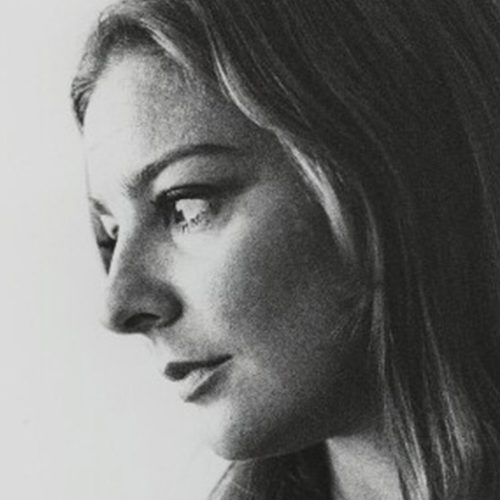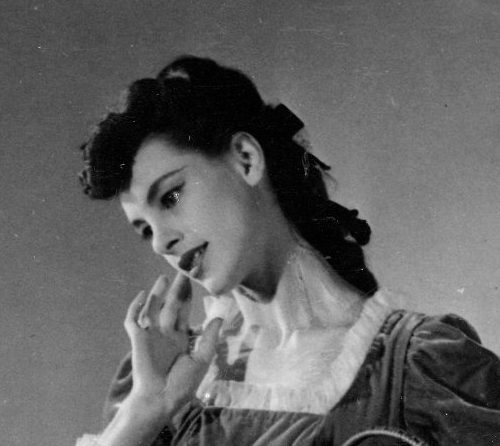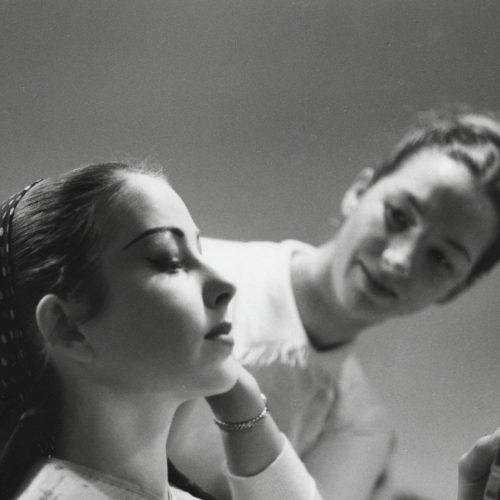By Anthony O'Hear, philosopher
Artists in Britain in the early and mid 20th Century were influenced by contemporary developments in Europe. However, they also looked back to a quintessentially native? Romanticism. There is no doubt that in their own choreography, de Valois, Ashton and other choreographers were also in tune with what we might call Neo Romanticism.
“These fragments I have shored against my ruins”
Eliot’s The Waste Land was published in 1922. At the time it was regarded as the quintessence of modernity or, to put it in art-historical terms, of modernism. It seemed to be ditching all the methods and beauty of traditional poetry in place of an apparently disjointed jumble of unintelligible references and images, a trend even more pronounced in Ezra Pound’s Cantos. In the visual arts in the 1920s Paris seemed to be the place to be, first with Cubism and then with an ever faster succession of artistic styles and challenges, iconoclastic figures like Picasso, Duchamp and Leger to the fore. Meanwhile, in music, Schoenberg and his school were re-writing the basic principles of composition. Architectural modernism, with all its angularity and brutality was gathering pace and influence, with figures such as Le Corbusier and Gropius to the fore, having learned from Loos that ornament was crime.
All this artistic ferment, much originating in continental Europe, naturally had its impact in Britain. After all, Eliot had chosen to live and work here. In the 1920s Henry Moore was producing his revolutionary sculptures, owing more, it seemed to many, to barbaric primitivism than to the tradition in which Michelangelo and Rodin might figure as exemplars. Even before the First World War in painting David Bomberg and Wyndham Lewis, with his Vorticism, had dabbled in cubism, with some success it might be thought, and in sculpture as early as 1913 Epstein had produced his radically mechanistic vison of a man as a brutal machine (Rock Drill). By the 1930s, moving with the artistic times, or at least with the international avant-garde, Ben Nicholson and his circle started producing purist abstraction, while somewhat in opposition to this trend, but still relentlessly modern, others such as Edward Burra and Paul Nash, seemed to be following in the footsteps of continental surrealism. Modernistic architecture, often designed by European emigrés, began to appear in parts of London and other cities in the 1930s, and while music in England was dominated by Elgar first and then Vaughan Williams, to the critics and some of his listeners William Walton seemed to have learned from exciting new musical developments.
What I want now to suggest in this short article is that in many respects important artists and writers in Britain in the 1930s owed far more to tradition, and often to an English or British tradition than to the continental avant-garde. Indeed, some of those who might have seemed to their contemporaries to be most modern, least English, if you like, turn out on examination to be most in touch with tradition and the past of this country. We can begin with Eliot himself. Even if the style of The Waste Land might seem bracingly, even aggressively, modern, in it the poet is, as he says, shoring up fragments against his ruins. And the fragments in question are shards from the past of European culture, to which far more reference is made here than in any poem of Eliot’s more traditional poetic contemporaries, such as Rupert Brooke or Wilfred Owen or A.E. Housman, however steeped they might be in a Georgian or even a Victorian pastoralism. What Eliot seems to be implying is that unless we can retrieve our roots, we will not survive culturally, or even personally, but that the way to do this is by forcing the reader to meet these remnants directly, even aggressively, and to let them resonate and fructify in the subconscious.
The Waste Land was written in 1922. By 1935, Eliot had published Burnt Norton, the first of his Four Quartets, his second great masterpiece (completed in 1944). In these poems, Eliot by now an Englishman, as well as a Royalist and an Anglo-Catholic, meditates on time, on choice, on sin and on redemption, but a recurring theme is our or his roots in England and English history: ‘History is now and England.’ This poet of the 1930s is rooted in Englishness and its meaning, very distant from the international modernist he might have appeared to the unwary in 1922. But there is very much a similar displacement of initial impression when we come to look at Henry Moore. Moore might have appeared to be a rootless revolutionary in his apparently clumsy, deliberately unbeautiful work, influenced not by the classical Greek tradition, but by traditions distant from us, such as the Egyptian, the Aztec and the Mayan. But as his career developed, even through an abstract phase and a flirtation with surrealism, we can increasingly see the meaning of the great Mother and Child and Reclining Figure sculptures he is so identified with from the 1930s onwards. Moore is not only celebrating the most natural and meaningful of human relationships, but the contours of his massive figures reflect the landscape of the English countryside, particularly the hilly, Pennine landscape where he was born and raised. As the child emerges from and nestles in the mother so are we encompassed in and emerge from this English landscape, which the sculptures reflect. The reclining figures are the sleeping lords of Arthurian legend, sleeping in the distant hills, or are themselves the distant hills, which is why they make so powerful and impression when they are situated out of doors in an English landscape. Moore, we can now in retrospect say, was never after ‘significant form’, as early critics had it, but rather the spiritual essence, or immanent being which underlies actual living forms, including those of nature itself.
In the opinion of many the most important British novelist of the mid-twentieth century was John Cowper Powys, and I say British here intentionally, because Powys made much of the British roots in Wales. His great novels on the laate twenties and the 1930s, including Wolf Solent (1929) and A Glastonbury Romance (1933), are in a way bang up to date. One begins in a train travelling from Waterloo Station, the other in a car journey past Stonehenge. In them, as well as trains and cars, there are aeroplanes, factories, communist revolutionaries, perverted antiquaries, vivisectionists, and discussions of sexuality and love, including homosexual love, utterly unthinkable before the 1920s, and even to-day raw and still at times shocking in their intensity. The towns portrayed are recognizably of their time as are the characters, who drink tea, teach in schools and run antique shops. But the characters and the events are seen in terms of and are even driven by ancient myths and a deep sense of place and the depth of time in the land beneath their feet. Powys’s achievement, like Eliot’s and Moore’s is, in a totally modern way, to see modern people in terms of time past and of the rhythms and the meanings gleaned from the past. Like Moore, he sees the immanent being underlying actual living forms. Like Eliot he sees contemporary life against the background of those vanished, and their myths, though with an earthiness, a sensuality and a robust humour quite beyond anything in Eliot.
In painting David Bomberg is emblematic of the way in which a number of British artists had by the 1930s renounced their earlier commitment to a form of international modernism in favour of a return to a kind of romanticism in a modern idiom, what came to be called neo-Romanticism. Before the First World War, Bomberg, along with Wyndham Lewis and the sculptor Epstein, among others, had engaged productively with a quasi-cubist aesthetic, in which the human beings represented are shown as mechanical constructions, with cylindrical or block-like limbs and bodies of wood or metal. In Bomberg’s case, this tendency is seen to powerful effect in his Mud Bath and his Vision of Ezechiel. But he was scarred by his experiences in the trenches of the First World War and renounced his earlier modernism in favour of figurative and landscape work. He discovered that human bodies were not made of wood or steel. In the 1920s his artistic turn consisted largely in somewhat flat, almost topographic work, particularly in Palestine. In the 1930s his output blossomed into stunning and vibrant work, landscape and portraiture, deeply expressionistic, first in Spain and then in Cyprus. In my view, Bomberg’s 1930 work – evoking the spirit in the mass, as he put it – is easily the equal of anything being done in Europe at the time, and strikingly original.
Bomberg may have been original in his approach, but he was by no means the only British artist producing visionary landscape in the 1930s. We can mention here Graham Sutherland, Ivon Hitchens, John Piper and Paul Nash in particular. Sutherland combined abstract, sometimes almost sinister, patterning with a dense investigation of vegetation, particularly in Pembrokeshire, a synthesis perhaps of surrealism and the kind of landscape detail associated in the past with Samuel Palmer. Hitchens was more fluid, almost expressionist, in his approach, full of poetic life and colour, a world away from the constrictions of cubism or the linearity of the surrealists and their contrived imaginings. John Piper is interesting from our point of view, because he began his artistic career in abstract mode, but by the mid-1930s was moving into landscape in a major way, including working on guidebooks and the depiction of church architecture. This fascination with the English countryside and history deepened markedly during the Second World War, when Piper developed the very romantic approach to landscape and the depiction of building, including ruins, for which he became famous particularly after the war. Finally in this round-up of what we might call English neo-Romantic painters prominent in the 1930s, we can turn to Paul Nash. Like Bomberg, Nash was in the trenches in the First World War, from which he produced a number of striking paintings, including We Are Making a New World from 1918. (In the Second World War he also painted Totes Meer in 1940-1, crashed planes in a wave like formation under an eerie moon.) All through the 1920s and 1930s Nash was painting strange and at times visionary landscapes, often including weirdly surreal objects in the landscapes, at times evoking worlds other than this. Although he exhibited with the surrealists in 1936, there is in Nash’s work none of the literalism or jokiness of the international surrealists; his work is notable for the way it makes apparently ordinary scenes, often from the coast and countryside of southern England, replete with mystery and disturbingly uncanny.
The fragments on which Bomberg, Sutherland, Hitchens, Piper and Nash all drew were all drawn from the rich landscape tradition of 18th and 19th century British painting. In their different ways they all drew artistic sustenance and inspiration both from the British countryside, and from the way it had been interpreted by its earlier depictors, such as Cotman, Turner and Samuel Palmer. Although they all drew in different ways on the art that was contemporary with them, they were un-modern in the way they all cherished the country and the way it had been approached by their artistic predecessors. However, before leaving the visual arts, we must mention Stanley Spencer, a major and unique figure, whose work resists easy categorization. However, even if it resists categorization, it is appropriate to mention it here, because while Spencer very much resisted contemporary artistic trends, he certainly drew on much that was based in English village life, rural and traditional. Like both Bomberg and Nash, Spencer painted in World War One, also producing one of the great works from that time, in his case, Travoys Arriving With Wounded Soldiers at a Dressing Station at Smol, Macedonia. Spencer was badly affected by the war, but this did not stop him from painting a superb Giotto-like series of frescoes evoking military life in the war for the Burghclere Chapel in 1927. Like Bomberg in Palestine, Spencer spent some time painting fairly conventional landscapes he did not really value, but what marks him out as wholly individual are the often strange, often rumbustious paintings he did mostly in and around Cookham where he lived, depicting aspects of village life, or rather of how Spencer imagined village life, in almost cartoonish style. Sometimes there is a semi-religious message behind them, sometimes something rather more profane, but many consider his famous Resurrection in Cookham Churchyard from 1921 an absolute masterpiece. In its quirkily humane earthiness, as the graves opening and their inhabitants clambering out, it is Spencer’s quintessential work. It should be said that when he wanted to be, Spencer was a superb naturalistic draftsman and painter, the equal of any twentieth century artist, including Lucian Freud. There is, though, something unique and unrepeatable about his vision, and something very English, in its way as English as Elgar or Vaughan Williams.
For reasons already given, we do not need to speak here about music. The music composed in Britain in the 1930s was comparatively untouched by the researches of the atonalists and serialists. Echoes of Stravinsky and Bartok can on occasion be heard in Walton, for example, but in an unmistakably English idiom. In a positive way the English composers of the time were rooted in what had become their tradition, their past. In architecture, while Lubetkin and Maxwell Fry were bringing their Gropius inspired designs to London and Cambridge, Lutyens was still active and the Anglican Cathedral in Liverpool was still taking shape. That Lutyens, one of the greatest of modern (though not modernist) architects and Liverpool Cathedral, one of the greatest twentieth century buildings in this country, are both ignored or passed over in many architectural histories, including Pevsner’s, is perhaps symptomatic of the way a certain cast of mind sees things only in terms of development away from the past, rather than as ideally being rooted in the past, albeit with evolutionary development.
But, as I have tried to show in this short essay is that in literature and the visual arts, major figures from the 1930s took what they could or needed from contemporary trends, but that they did so without losing their roots or their Britishness. Like Eliot, consciously or unconsciously, in the 1930s they were gathering fragments from their past against the ruins that were about to engulf them.



